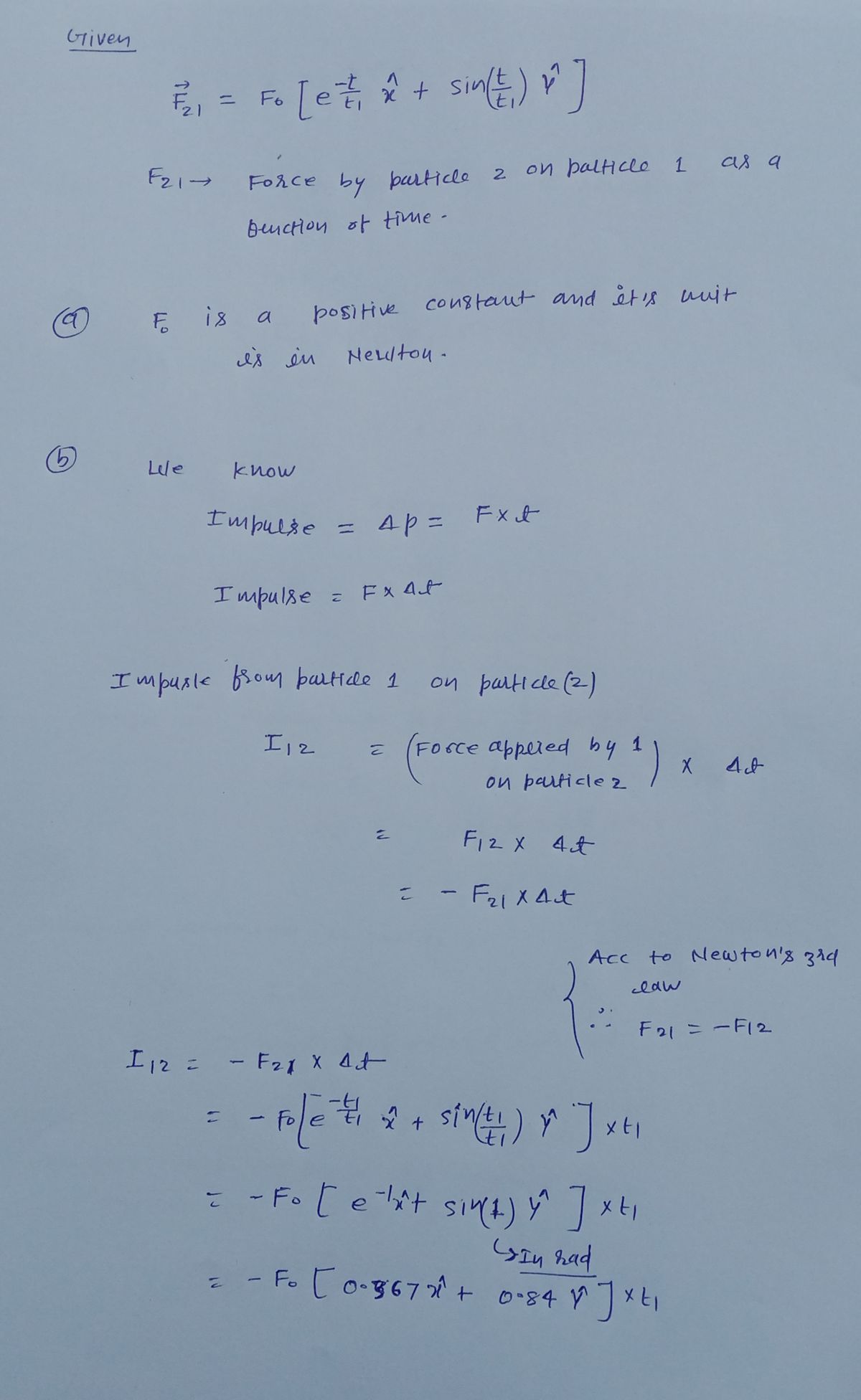Disclaimer: if this problem is chosen for the mini-exam, the given function may be different, but will be chosen from the exponential, trigonometric, or polynomial families. * There are two particles (1 and 2) that are moving around in space. The mass of particle 1 is m1 and the mass of particle 2 is m2. The particles are isolated so that only the forces between the particles are significant. The force that 2 exerts on 1 is given by: 2. F1(t) = Fo e î + sin where F, and t, are both constants. The particles interact with one another from t = 0 until t = t1. a. What is the physical meaning of F,? b. Find the impulse from particle 1 on particle 2 over this time interval. c. Find the impulse from particle 2 on particle 1 over this time interval. d. Find the change in momentum of particle 1 over this time interval. e. Find the change in momentum of particle 2 over this time interval. f. Find the change in momentum of the system that consists of particle 1 and particle 2 over this time interval.
Disclaimer: if this problem is chosen for the mini-exam, the given function may be different, but will be chosen from the exponential, trigonometric, or polynomial families. * There are two particles (1 and 2) that are moving around in space. The mass of particle 1 is m1 and the mass of particle 2 is m2. The particles are isolated so that only the forces between the particles are significant. The force that 2 exerts on 1 is given by: 2. F1(t) = Fo e î + sin where F, and t, are both constants. The particles interact with one another from t = 0 until t = t1. a. What is the physical meaning of F,? b. Find the impulse from particle 1 on particle 2 over this time interval. c. Find the impulse from particle 2 on particle 1 over this time interval. d. Find the change in momentum of particle 1 over this time interval. e. Find the change in momentum of particle 2 over this time interval. f. Find the change in momentum of the system that consists of particle 1 and particle 2 over this time interval.
College Physics
11th Edition
ISBN:9781305952300
Author:Raymond A. Serway, Chris Vuille
Publisher:Raymond A. Serway, Chris Vuille
Chapter1: Units, Trigonometry. And Vectors
Section: Chapter Questions
Problem 1CQ: Estimate the order of magnitude of the length, in meters, of each of the following; (a) a mouse, (b)...
Related questions
Question

Transcribed Image Text:Disclaimer: if this problem is chosen for the mini-exam, the given function may be different, but will be
chosen from the exponential, trigonometric, or polynomial families. * There are two particles (1 and 2) that
are moving around in space. The mass of particle 1 is m1 and the mass of particle 2 is m2. The particles are
isolated so that only the forces between the particles are significant. The force that 2 exerts on 1 is given by:
2.
F1(t) = Fo e
î + sin
where F, and t, are both constants. The particles interact with one another from t = 0 until t = t1.
a. What is the physical meaning of F,?
b. Find the impulse from particle 1 on particle 2 over this time interval.
c. Find the impulse from particle 2 on particle 1 over this time interval.
d. Find the change in momentum of particle 1 over this time interval.
e. Find the change in momentum of particle 2 over this time interval.
f. Find the change in momentum of the system that consists of particle 1 and particle 2 over this time interval.
Expert Solution
Step 1

Trending now
This is a popular solution!
Step by step
Solved in 2 steps with 2 images

Knowledge Booster
Learn more about
Need a deep-dive on the concept behind this application? Look no further. Learn more about this topic, physics and related others by exploring similar questions and additional content below.Recommended textbooks for you

College Physics
Physics
ISBN:
9781305952300
Author:
Raymond A. Serway, Chris Vuille
Publisher:
Cengage Learning

University Physics (14th Edition)
Physics
ISBN:
9780133969290
Author:
Hugh D. Young, Roger A. Freedman
Publisher:
PEARSON

Introduction To Quantum Mechanics
Physics
ISBN:
9781107189638
Author:
Griffiths, David J., Schroeter, Darrell F.
Publisher:
Cambridge University Press

College Physics
Physics
ISBN:
9781305952300
Author:
Raymond A. Serway, Chris Vuille
Publisher:
Cengage Learning

University Physics (14th Edition)
Physics
ISBN:
9780133969290
Author:
Hugh D. Young, Roger A. Freedman
Publisher:
PEARSON

Introduction To Quantum Mechanics
Physics
ISBN:
9781107189638
Author:
Griffiths, David J., Schroeter, Darrell F.
Publisher:
Cambridge University Press

Physics for Scientists and Engineers
Physics
ISBN:
9781337553278
Author:
Raymond A. Serway, John W. Jewett
Publisher:
Cengage Learning

Lecture- Tutorials for Introductory Astronomy
Physics
ISBN:
9780321820464
Author:
Edward E. Prather, Tim P. Slater, Jeff P. Adams, Gina Brissenden
Publisher:
Addison-Wesley

College Physics: A Strategic Approach (4th Editio…
Physics
ISBN:
9780134609034
Author:
Randall D. Knight (Professor Emeritus), Brian Jones, Stuart Field
Publisher:
PEARSON